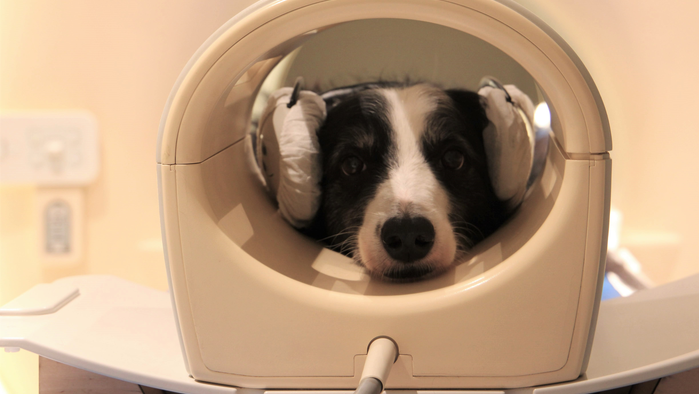Dogs can differentiate between familiar and unfamiliar human languages
They are the first non-human animals to be able to tell the difference between human languages.
If you were to move to a new country with a different language and bring along the family dog, your pet would likely have a hard time understanding commands from the locals, according to a new study looking at how dogs' brains react to different languages.
MRI scans revealed that dogs' brains can distinguish between familiar and unfamiliar languages, making them the first-known, and so far only, non-human animals to be able to tell the difference between human languages.
The new study, which was published online Dec. 12, 2021, in the journal NeuroImage, was conceived by lead author Laura Cuaya, a neurobiologist at Eötvös Loránd University in Hungary, who recently moved from Mexico to Budapest alongside her dog Kun-kun.
Related: 10 things you didn't know about dogs
"We noticed that the people in Budapest were very friendly with dogs and often approached Kun-kun and talked to him," Cuaya told Live Science. "Kun-kun usually pays a lot of attention to people, so I wondered whether he noticed that people in Budapest speak a different language."
Cuaya and her team trained 18 dogs, including Kun-kun, to lie motionless in an MRI machine so the researchers could scan their brains. As the dogs were being scanned, the researchers played the canines three different recordings: a Spanish reading from the famous children's book "The Little Prince;" a Hungarian reading from the same book; and a series of human noises that did not resemble speech at all. All of the dogs had been exposed to only one of the two languages, meaning one was familiar to them and the other was unfamiliar.
The brain scans suggested that not only were the dogs able to clearly distinguish between speech and non-speech, but they also reacted differently to familiar and unfamiliar languages, according to a statement by the researchers.
Get the world’s most fascinating discoveries delivered straight to your inbox.
The researchers suspect that the the primary auditory cortex and secondary auditory cortex in dogs' brains (both located within the temporal cortex that sits at about ear level in the skull) allow dogs to process speech in two steps, known as "hierarchy processing," Cuaya said. "The primary auditory cortex detects whether a sound is speech or not," she said. "Then, the secondary auditory cortex differentiates between a familiar and an unfamiliar language."
During the experiments, researchers also found that older dogs showed more activity in the secondary auditory cortex of the brain, suggesting they were better at differentiating familiar and unfamiliar languages than younger dogs. "I think that the main reason [that older dogs are better at differentiating languages] is the amount of exposure to the language," Cuaya said. "Older dogs have had more opportunities to listen to humans while they talk."
The researchers suspect that dogs are not the only animals capable of telling the difference between human languages. "The brain is extremely good at picking up patterns, and each language has a series of sounds and patterns that makes them different from each other," Cuaya said. "After some training, the brain of many animals should be able to recognize these patterns."
However, what makes dogs unique is that they do not need to be trained to distinguish between human languages. "Their brains detected the difference spontaneously, perhaps due to the domestication process," Cuaya said. "While it is possible that many species can distinguish between human languages, dogs are one of the few that are interested in hearing us."
Previous research has shown that dogs can even tell when people are lying to them, Live Science previously reported.
Cuaya was "a little surprised" by the study's findings, but she also thinks that many people underestimate how sharp our canine friends can be.
"My experience with dogs has shown me that they are constantly paying attention to their social world and everything that happens around them," Cuaya said. "I think dogs know more about us than we imagine."
Originally published on Live Science.

Harry is a U.K.-based senior staff writer at Live Science. He studied marine biology at the University of Exeter before training to become a journalist. He covers a wide range of topics including space exploration, planetary science, space weather, climate change, animal behavior and paleontology. His recent work on the solar maximum won "best space submission" at the 2024 Aerospace Media Awards and was shortlisted in the "top scoop" category at the NCTJ Awards for Excellence in 2023. He also writes Live Science's weekly Earth from space series.




